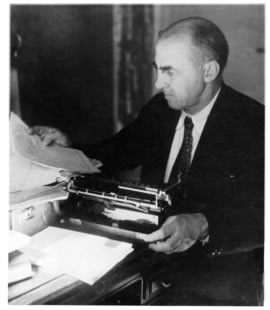In this postmodern, post-macho era, you’re not supposed to have heroes – to the point that most modern kids’ heroes are lame (Ash in Pokemon, Mickey Mouse, Mario, Ben 10, dare I say Harry Potter for most of the books?). Who now doesn’t honestly prefer antiheroes like Team Rocket, Bugs Bunny, Wario, Kevin 11, Voldemort?
Well, I don’t care much for trends: my #1 historian hero is Lynn Thorndike. Hence, as a Voynich manuscript researcher, I always wanted to know what he thought of this troublesome artefact: and while trawling through his (1929) “Science & Thought in the Fifteenth Century” in 2008 was delighted to discover that Thorndike thought Newbold’s claimed decryption was, frankly, nonsense.
But now I can go one better: on the Roger Bacon wikipedia page, someone recently edited in a link to a 1929 review Thorndike wrote in American Historical Review Vol. 34, No. 2 (Jan., 1929), pp. 317-319 on JSTOR. Oooh, I tell ya, that Mr Thorndike didn’t think that his late friend Professor Newbold would have wanted to see his notes published like that; and he wasn’t at all impressed that it went out under the august auspices of the University of Pennsylvania.
You also get a sense of Thorndike’s frustration at constantly being asked his opinion on “an anonymous manuscript of dubious value”. If I had stepped out of the Tardis to ask him about the Voynich Manuscript circa 1929, he might very well have grouchily punched my lights out.
“I should like to be able to force every one who asks me my opinion of the Voynich manuscript to read [Newbold’s] book from cover to cover. I think it will either kill or cure.”
Even though Thorndike’s review doesn’t go so far as to offer his own opinion, he does ironically predict the whole sad demented future of Voynich research, for which we should perhaps be grateful:-
“I would offer the ironic suggestion that the illegible writing is only a blind, and the the pictures should be interpreted symbolically, were I not afraid that some self-constituted successor to Newbold would take the suggestion seriously.”
Now ain’t that the truth, brothers and sisters of the faith? Oh, well! *sigh*

Nick
This is wonderful.
May I add, most *un*emphatically, that what strikes me in Thorndike’s final comment is that he might if he wished have used the word allegorical – rather than ‘symbolic’ – and did not.
Can truth be stranger than fiction?
Apparently, Rudolph II spent his earliest years with “relatives” in Italy. I can just see that little boy, “out of his skull” with boredom, having to practice his handwriting skills…..
May I make reference to a feature that “Rudy” inherited through the Habsburg intermarriages? The prognathous jaw. Almost a sure indicator of an early death for Habsburg men. I wonder how long Rudy’s brother Matthias lived.
Refresh my memory, Nick. When I was in my teens (1950’s) I read some of Thorndike’s writings, I just can’t remember the context, except I was reading Ayn Rand, Taylor Caldwell, Thor Heyerdahl, and James Michener. Am I way off-track/subject, here?
This is as good a place as any to ask – Did Roger Bacon devise one or more ciphers, and if so- any online source that you’d recommend for their explanation?
This isn’t to do, particularly, with the Voynich manuscript I might add.
I just followed the link to Thorndike’s review – he’s certainly firm, if not so informative.
John Manley Matthews’ was more so, and shows Newbold’s mind fading with a sense both of deep affection and real tragedy – not least because in the end intellectual integrity is the best homage to his late friend.
So said – reading Manley’s list of eminent scholars and scientists who accepted Newbold’s views, I begin to understand why some in the Voynich mailing list are so indifferent to formal method or academic conventions.
You know, if I were a cipher-type, I’d consider Bacon’s portrait. He looks as if he has a sphere whose upper part can be twisted against the lower – possibly as illustration of the principle that the world seems to turn one way,but heaven another. Still, if you had a sphere like that, marked with 17 (or whatever) letters about the rim, and an upper one similarly marked, rotating them against each other would give an instant key, wouldn’t it?
A kind of simplified astrolabe, without the geography-at-the-back.
In the thirteenth century, I’d imagine, it would be easy enough for a predominantly verbal-oriented scholar to assign relative values and then to encipher by.. I don’t know – shifting the prime meridian to accord with the breviaries’ hours or something.
People back then made ciphers from the sort of things they had to memorise and knew pretty much by heart… didn’t they?
Not about the Voynich – just musing about the idea and what sort of cipher Bacon might, theoretically, construct.